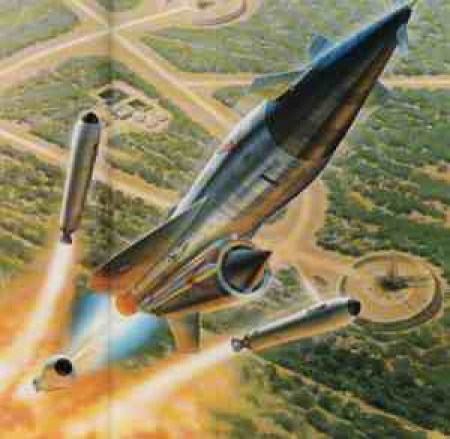Forty-six years ago this month, the United States abandoned a 7-year effort to develop a nuclear-armed, supersonic cruise missile. The joint USAF-AEC program was known as Project Pluto. The centerpiece of this program was the nuclear-fueled, ramjet-powered Supersonic Low-Altitude Missile (SLAM).
The 1950’s saw the development of myriad aircraft, missile and submarine concepts designed for delivery of nuclear weaponry over strategic distances. This developmental activity was driven by the escalating Cold War between the United States and the Soviet Union. In addition to weapons, the power of the atom was also considered for propulsion applications during this era.
SLAM was perhaps the most fearsome weapon ever conceived. The missile was designed to deliver as many as 26 nuclear bombs over the Soviet Union in a single mission. It would do this while flying at Mach 3 and less than 1,000 feet above ground level. SLAM’s shock wave overpressure alone (162 dB) would devastate structures and people along its flight path. And, as if that were not enough, the type’s nuclear-fueled ramjet would continuously spew radiation-contaminated exhaust all over the countryside.
The SLAM airframe was huge. It measured 88 feet in length, nearly 6 feet in diameter and weighed 61,000 pounds at launch. The vehicle would be fired from a ground-based launch site and accelerated to ramjet takeover speed by a trio of jettisionable rocket boosters. The nuclear-fueled ramjet was rated at 35,000 pounds of thrust.
To find its way to the target area(s), the Ling-Temco-Vought (LTV) SLAM would use a guidance system known today as TERCOM – Terrain Contour Matching. At a target, SLAM would eject an atomic warhead upwards from its payload bay. The resulting lofted trajectory gave SLAM time to depart the hot target area prior to weapon detonation. Following completion of its mission, the missile would then ditch itself by diving into a deep ocean graveyard.
The heart of the Project Pluto missile was the nuclear-fueled ramjet. An unshielded nuclear reactor, code named TORY, was devised, built and successfully tested. Testing was conducted at a special-purpose test site in Nevada. In its Tory II-C configuration, the SLAM ramjet produced over 500 megawatts of power in 5 minutes of continuous operation during a test conducted in May of 1964.
SLAM’s nap-of-the-earth, supersonic flight profile would subject the airframe to terrific airloads, vibrations and temperatures. The Project Pluto team successfully devised structural and thermal material solutions to handle the daunting flight environment. In addition, nuclear-hardened electronics and flight controls were successfully developed.
From a technological standpoint, Project Pluto proved to be entirely viable. However, doubts about its implementation started to arise as flight testing of the nuclear-powered missile was seriously considered. Where do you flight-test a radiation-spewing missile? What happens if you can’t turn-off the reactor? What do you do if the guidance system fails? Where do you dispose of the missile after a flight test? These and other disturbing questions began to trouble program officials.
Coupled with the above practical concerns of SLAM flight testing were growing political and mission obsolesence issues. Pentagon officials ultimately deemed Project Pluto as being highly provocative to the Soviet Union in the sense that the communist super power might feel compelled to develop their own SLAM. Further, American missilery was quickly developing to the point where ICBM-delivered warheads would do the job and at a lower per-unit cost.
So it was that on Wedneday, 01 July 1964, Project Pluto was canceled after 7 years of fruitful development. While no airframe was ever built and tested, SLAM technology was applied to a host of subsequent aerospace vehicle developments.
SLAM would truly have been “The Missile From Hell” had it matured to the point of flight. Indeed, the ethical issues concerning the missile’s use were quite sobering. And, owing to Murphy’s Law and its many corollaries, the chances for unintended catastrophe were high as well. Despite the allure of this “technically sweet” solution to a national defense problem, the decision to cancel Project Pluto was ultimately the only correct course to follow.



Comments
Nice website/blog. Just found it today and enjoyed reading your articles. Thanks for the nice piece on my dad, Scott Crossfield
Share this post:
Hello Sally,
Thank you very much for your kind comments about our web site and weekly aerospace history blog. The aerospace history articles are especially fun to do. Your father certainly made his share of contributions to the advancement of high-speed flight in America. You must be very proud of him! Thank you again for taking the time to write us. I hope become a regular visitor to our blog. All the best to you and your family!
Share this post:
“the ethical issues concerning the missile’s use were quite sobering”
Gosh, we wouldn’t want a missile that was only going to be used for NUCLEAR WAR to be “unsafe” and environmentally unfriendly, would we?
Share this post:
Wow! Finally, the doomsday weapon is revealed. But why didn’t we tell the world?
Share this post:
HI; I WORKED ON THIS PROJECT AS A RAMJET WIND TUNNEL TEST ENGINEER FOR MARQUARDT AIRCRAFT COMPANY IN VAN NUYS, CA. WE TESTED VARIOUS PROPELLANT COMBINATIONS INCLUDING 90% H2O2, JP4 AND VARIOUS HYPERGOLIC FULES. THE EXTREME TESTING TEMPERATURES REQUIRED THE USE OF A SPECIAL PAINT ON THE TEST UNITS SO THAT WE COULD DISCERN THE VALUES REACHED! THESE TESTS WERE CONDUCTED AT VARIOUS ALTITUDES, MACH NUMBERS AND ANGLES OF ATTACK.
LATER WE BUILT A FULL SCALE MOCK-UP OF THE NUCLEAR REACTOR ENGINE TO BE USED IN RAMJET MISSILE DESIGNS AND DID WORK ON THE PLUTO (SLAM) PROJECT. THE PROSPECT OF HAVING SUCH A MISSILE LOITERING IN THE STRATOSPHERE JUST WAITING TO BE CALLED DOWN TO DESTROY THE WORLD WAS A FEARFUL CONCEPT!
Share this post:
…it’s much too late, but actually the missile wasn’t supposed to drop itself into the ocean. After it ran out of warheads, at least one hypothetical tactic was to program it to ram itself into one last target and self-destruct, spraying white-hot molten plutonium from the reactor core and creating a contaminated area miles across.
Share this post: